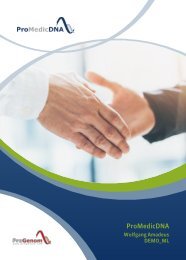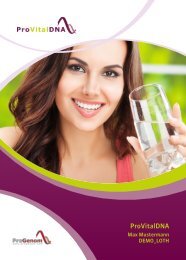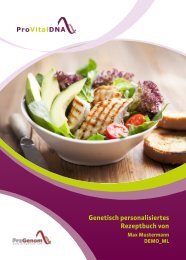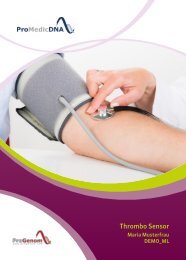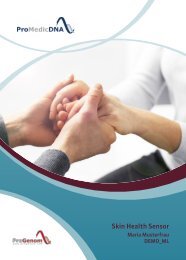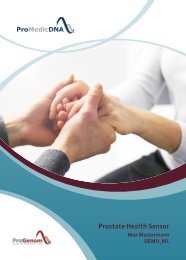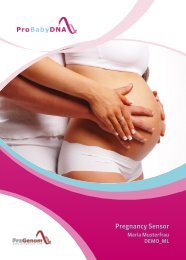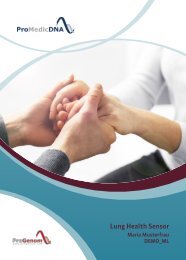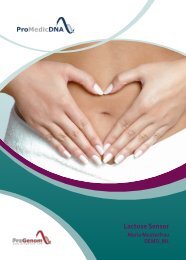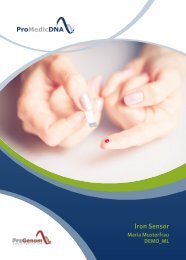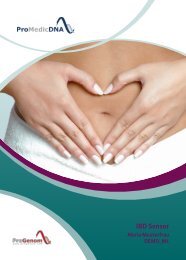Baby Breast Milk Sensor DEMO DE
nicht medizinische Analyse - ProBabyDNA medizinische Analyse (Schweiz)
nicht medizinische Analyse - ProBabyDNA
medizinische Analyse (Schweiz)
You also want an ePaper? Increase the reach of your titles
YUMPU automatically turns print PDFs into web optimized ePapers that Google loves.
<strong>Breast</strong> <strong>Milk</strong> <strong>Sensor</strong><br />
Maria Musterfrau<br />
<strong><strong>DE</strong>MO</strong>_ML
ANSCHREIBEN<br />
Sehr geehrte Frau Musterfrau,<br />
Ihre Probe für die Analyse ist am 25/11/2020 bei uns im Labor eingetroffen und wurde<br />
anschließend nach höchsten Labor-Qualitätsstandards untersucht. Die Ergebnisse<br />
wurden anschließend von 2 unabhängigen Genetikern und Molekularbiologen<br />
ausgewertet und freigegeben. Nach der Freigabe wurde Ihr persönlicher Bericht<br />
individuell für Sie zusammengestellt. Diesen möchte ich Ihnen hiermit in der<br />
gewünschten Form übermitteln.<br />
Wir bedanken uns herzlich für Ihr Vertrauen und hoffen, dass Sie mit unserem Service<br />
zufrieden sind. Wir freuen uns über Ihre Fragen und Anregungen, denn nur so können<br />
wir unseren Service kontinuierlich verbessern.<br />
Wir hoffen, die Analyse erfüllt Ihre Erwartungen.<br />
Mit freundlichen Grüssen<br />
Dr. Daniel Wallerstorfer BSc.<br />
Labordirektor<br />
Florian Schneebauer, MSc.<br />
Laborleiter
<strong>Breast</strong> <strong>Milk</strong> <strong>Sensor</strong><br />
Analysebericht<br />
Maria Musterfrau | geboren: 01/01/1990<br />
Bestellnummer:<br />
<strong><strong>DE</strong>MO</strong>_ML<br />
Dieser Bericht beinhaltet persönliche medizinische und genetische Daten<br />
und ist vertraulich zu behandeln.<br />
<strong><strong>DE</strong>MO</strong>_ML Seite 1 von 23
EINLEITUNG<br />
DAS ERGEBNIS<br />
WISSENSCHAFT<br />
ZUSATZINFORMATIONEN
MUTTERMILCH<br />
Die richtige Nährstoffversorgung für Ihr <strong>Baby</strong>
MUTTERMILCH<br />
Die Auswirkung von Muttermilch auf die<br />
Entwicklung eines <strong>Baby</strong>s<br />
Während den ersten sechs Monaten des Lebens ist Ihr <strong>Baby</strong> vollkommen<br />
auf die richtige Balance an lebenswichtigen Nährstoffen in der<br />
Muttermilch angewiesen. Diese enthält alles was Ihr <strong>Baby</strong> benötigt in<br />
entweder der perfekten oder nahezu perfekten Menge um eine schnelle<br />
Entwicklung des Körpers und Gehirns Ihres <strong>Baby</strong>s sicherzustellen.<br />
Allerdings beeinflussen mehrere<br />
Umwelteinflüsse die Menge an Omega 3 in<br />
der Muttermilch und zahlreiche<br />
wissenschaftliche Studien haben gezeigt,<br />
dass dies einen negativen Einfluss auf die<br />
Entwicklung des Kindes haben kann. Dieser<br />
wichtige Baustein wird benötigt, um neue<br />
Zellmembranen in allen Geweben, besonders<br />
im Gehirn zu erstellen.<br />
Wenn die Zufuhr an Omega 3 Fettsäuren<br />
während der Gehirnentwicklung zu gering ist,<br />
kann sich die Entwicklung dadurch<br />
verlangsamen und zu einem niedrigeren<br />
Intelligenzquotienten (IQ) niedrigerem<br />
Omega 3 Gehalt in roten Blutzellen,<br />
schlechterer Sicht und langsamer mentaler<br />
Entwicklung führen. Auch wenn die Menge an<br />
Omega 3 zu einem späteren Zeitpunkt erhöht<br />
wird, können die Auswirkungen einer<br />
langsameren Entwicklung nicht mehr<br />
aufgeholt werden.<br />
Deswegen ist es besonders wichtig für Eltern<br />
sicherzugehen, dass das <strong>Baby</strong> durch die<br />
Muttermilch die notwendigen Nährstoffe in<br />
der richtigen Menge bekommt. Die Analyse<br />
der Muttermilch auf Omega 3 Gehalt ist ein<br />
fortschrittlicher und verlässlicher Weg, um<br />
den Omega 3 Gehalt der Muttermilch zu<br />
analysieren und falls nötig durch eine<br />
angepasste Ernährung und<br />
Nahrungsergänzungsmittel zu erhöhen.<br />
Omega 3 Fettsäuren haben mehrere<br />
Funktionen in der Entwicklung Ihres Kindes:<br />
Zellmembranen herstellen<br />
Omega 3 Fettsäuren sind ein essenzieller<br />
Baustein für die Zellmembranen. Während<br />
den ersten sechs Lebensmonaten bekommt<br />
Ihr <strong>Baby</strong> Omega 3 nur durch die Muttermilch<br />
und benötigt genug um 2 000 000 000 000<br />
neue Zellen zu bilden.<br />
Gehirnentwicklung und IQ<br />
Besonders Gehirnzellen benötigen eine<br />
grosse Menge an Omega drei Fettsäuren<br />
während der Entwicklung. Bestimmte<br />
Regionen im Gehirn (Cerebellum, prefrontale<br />
Kortex und Hippocampus) entwickeln nur<br />
während den ersten zwei Lebensjahren neue<br />
Zellen. Nach dem Alter von zwei Jahren kann<br />
auch mit einem besonders hohen Omega drei<br />
Gehalt im Blut die versäumte Entwicklung<br />
nicht nachgeholt werden. Wissenschaftliche<br />
Studien haben gezeigt, dass <strong>Baby</strong>s, die mit<br />
Omega 3 angereicherter Milch gestillt wurden<br />
bis zu sechs IQ Punkte mehr aufwiesen.<br />
Omega 3 und Entwicklung<br />
<strong><strong>DE</strong>MO</strong>_ML Seite 4 von 23
Augenentwicklung<br />
Omega 3 spielt auch eine wichtige Rolle in der<br />
Entwicklung der Augen. Wissenschaftliche<br />
Studien haben gezeigt, dass Kinder mit einem<br />
höheren Omega 3 Gehalt im Blut früher klare<br />
Sicht entwickeln als Kinder mit einem<br />
niedrigen Omega 3 Gehalt.<br />
<strong><strong>DE</strong>MO</strong>_ML Seite 5 von 23
EINLEITUNG<br />
DAS ERGEBNIS<br />
WISSENSCHAFT<br />
ZUSATZINFORMATIONEN
ERGEBNIS<br />
Erfahren Sie hier alles über unsere Auswertungen und Ihr Ergebnis
BREAST MILK SENSOR<br />
Das Ergebnis - Monat 18<br />
Hier sehen Sie das Ergebnis der Omega-3 (genauer DHA) Messung aus Ihrer Probe.<br />
3. Trimester<br />
MUTTER-<br />
MILCH<br />
GEBURT<br />
FESTE<br />
NAHRUNG<br />
Monat 1<br />
Monat 2<br />
Monat 3<br />
Monat 4<br />
Monat 5<br />
Monat 6<br />
Monat 7<br />
Monat 18 Analyseergebnis<br />
ZU NIEDRIG MÄSSIG OPTIMAL<br />
▲<br />
Ihr Ergebnis: 0.03% Omega-3 (DHA/EPA)<br />
Der Omega 3 Gehalt ist zu niedrig und sollte<br />
durch Einnahme von OMEGA 3 Kapseln und<br />
Ernährungsumstellung erhöht werden.<br />
Monat 8<br />
Monat 9<br />
Monat 10<br />
Monat 11<br />
1. Geburtstag<br />
1,5 Jahre alt<br />
<strong><strong>DE</strong>MO</strong>_ML Seite 8 von 23
EINLEITUNG<br />
DAS ERGEBNIS<br />
WISSENSCHAFT<br />
ZUSATZINFORMATIONEN
WISSENSCHAFT<br />
Dieses Kapitel zeigt die Wissenschaft hinter dem Test.
LITERATURVERWEIS<br />
Literaturverweis<br />
Alle unsere Analysen, Technologien und medizinischen Empfehlungen sind<br />
wissenschaftlich validiert. Hier finden Sie einen Ausschnitt der<br />
wissenschaftlichen Literatur, die dazu als Basis dient.<br />
➤ ACOG Updates Definitive Guide to Pregnancy: Your Pregnancy & Birth, Fourth Edition, Gives<br />
Women the Latest News on Genetic Disorders, Prenatal Tests, DOs and DON’Ts, and Exercise<br />
➤ Bell et al., The new dietary fats in health and disease. J Am Diet Assoc. 1997, 97:280–286. quiz<br />
287–288.<br />
➤ Berman et al., Docosahexaenoic acid confers neuroprotection in a rat model of perinatal hypoxiaischemia<br />
potentiated by Escherichia coli lipopolysaccharide-induced systemic inflammation. Am J<br />
Obstet Gynecol. 2010;202:469.e1–e6.<br />
➤ Berman et al., Treatment with docosahexaenoic acid after hypoxia-ischemia improves forepaw<br />
placing in a rat model of perinatal hypoxiaischemia. Am J Obstet Gynecol. 2010;203:385.e1–e5.<br />
➤ Bernard et al. <strong>Breast</strong>feeding, Polyunsaturated Fatty Acid Levels in Colostrum and Child<br />
Intelligence Quotient at Age 5-6 Years. J Pediatr. 2017 Apr;183:43-50.e3.<br />
➤ Bisgaard et al. Fish Oil-Derived Fatty Acids in Pregnancy and Wheeze and Asthma in Offspring. N<br />
Engl J Med. 2016 Dec 29;375(26):2530-9.<br />
➤ Bloomingdale et al., A qualitative study of fish consumption during pregnancy. Am J Clin Nutr.<br />
2010, 92:1234–1240.<br />
➤ Bouwstra et al. Neurologic condition of healthy term infants at 18 months: positive association<br />
with venous umbilical DHA status and negative association with umbilical trans-fatty acids.<br />
Pediatr Res. 2006 Sep;60(3):334-9. Epub 2006 Jul 20.<br />
➤ Braunholtz et al., Are randomized clinical trials good for us (in the short term)? Evidence for a “trial<br />
effect” J Clin Epidemiol. 2001;54:217–224.<br />
➤ Bulstra et al., The effects of 3g eicosapentaenoic acid daily on recurrence of intrauterine growth<br />
retardation and pregnancy induced hypertension. Br J Obstet Gynaecol. 1995;102:123–126.<br />
➤ Coletta et al., Omega-3 Fatty Acids and Pregnancy, Rev Obstet Gynecol. 2010 Fall, 3(4): 163–171.<br />
➤ da Rocha et al. High dietary ratio of omega-6 to omega-3 polyunsaturated acids during pregnancy<br />
and prevalence of post-partum depression. Matern Child Nutr. 2012 Jan;8(1):36-48.<br />
➤ De Giuseppe et al. n-3 LC-PUFA supplementation: effects on infant and maternal outcomes. Eur J<br />
Nutr. 2014 Aug;53(5):1147-54.<br />
➤ Dunstan et al. Cognitive assessment of children at age 2(1/2) years after maternal fish oil<br />
supplementation in pregnancy: a randomised controlled trial. Arch Dis Child Fetal Neonatal Ed.<br />
2008 Jan;93(1):F45-50. Epub 2006 Dec 21.<br />
➤ Dunstan et al. Fish oil supplementation in pregnancy modifies neonatal allergen-specific immune<br />
responses and clinical outcomes in infants at high risk of atopy: a randomized, controlled trial. J<br />
Allergy Clin Immunol. 2003 Dec;112(6):1178-84.<br />
➤ Freeman et al., Omega-3 fatty acids and supportive psychotherapy for perinatal depression: a<br />
randomized placebo-controlled study. J Affect Disord. 2008;110:142–148.<br />
➤ Frithsen et al., Awareness and implications of fish consumption advisories in a women’s health<br />
setting. J Reprod Med. 2009, 54:267–272.<br />
➤ Furuhjelm et al. Fish oil supplementation in pregnancy and lactation may decrease the risk of<br />
infant allergy. Acta Paediatr. 2009;98:1461–1467.<br />
<strong><strong>DE</strong>MO</strong>_ML Seite 12 von 23
➤ Golding et al., High levels of depressive symptoms in pregnancy with low omega-3 fatty acid intake<br />
from fish. Epidemiology. 2009;20:598–603.<br />
➤ Graham et al., A systematic review of the role of intrapartum hypoxia-ischemia in the causation of<br />
neonatal encephalopathy. Am J Obstet Gynecol. 2008;199:587–595.<br />
➤ Greenberg et al., Omega-3 fatty acid supplementation during pregnancy. Rev Obstet Gynecol.<br />
2008, 1:162–169.<br />
➤ Harper et al., Eunice Kennedy Shriver National Institute of Child Health and Human Development<br />
Maternal-Fetal Medicine Units Network. Omega-3 fatty acid supplementation to prevent recurrent<br />
preterm birth. Obstet Gynecol. 2010;115:234–242.<br />
➤ Hauner et al. Effect of reducing the n-6:n-3 long-chain PUFA ratio during pregnancy and lactation<br />
on infant adipose tissue growth within the first year of life: an open-label randomized controlled<br />
trial. Am J Clin Nutr. 2012 Feb;95(2):383-94.<br />
➤ Helland et al. Maternal supplementation with very-long-chain n-3 fatty acids during pregnancy and<br />
lactation augments children’s IQ at 4 years of age. Pediatrics. 2003;111:e39–e44.<br />
➤ Helland et al., Similar effects on infants of n-3 and n-6 fatty acids supplementation to pregnant<br />
and lactating women. Pediatrics. 2001;108:E82<br />
➤ Helland et al. Effect of supplementing pregnant and lactating mothers with n-3 very-long-chain<br />
fatty acids on children's IQ and body mass index at 7 years of age. Pediatrics. 2008<br />
Aug;122(2):e472-9.<br />
➤ Hibbeln et al. Maternal seafood consumption in pregnancy and neurodevelopmental outcomes in<br />
childhood (ALSPAC study): an observational cohort study. Lancet. 2007;369:578–585<br />
➤ Hibbeln et al. Seafood consumption, the DHA content of mothers' milk and prevalence rates of<br />
postpartum depression: a cross-national, ecological analysis. J Affect Disord. 2002<br />
May;69(1-3):15-29.<br />
➤ Innis et al., . Essential n-3 fatty acids in pregnant women and early visual acuity maturation in<br />
term infants. Am J Clin Nutr. 2008, 87:548–557.<br />
➤ Jacobson et al. Beneficial effects of a polyunsaturated fatty acid on infant development: evidence<br />
from the inuit of arctic Quebec. J Pediatr. 2008 Mar;152(3):356-64.<br />
➤ Jensen CL. Effects of n-3 fatty acids during pregnancy and lactation, Am J Clin Nutr. 2006, 83(6<br />
suppl):1452S–1457S.<br />
➤ Koletzko et al. Current information and Asian perspectives on long-chain polyunsaturated fatty<br />
acids in pregnancy, lactation, and infancy: systematic review and practice recommendations from<br />
an early nutrition academy workshop. Ann Nutr Metab. 2014;65(1):49-80.<br />
➤ Koletzko et al. Should Women Providing <strong>Milk</strong> to Their Preterm Infants Take Docosahexaenoic Acid<br />
Supplements? Clin Perinatol. 2017 Mar;44(1):85-93.<br />
➤ Koletzko et al., Lipid Intake Working Group<br />
➤ Koletzko et al., World Association of Perinatal Medicine Dietary Guidelines Working Group,<br />
authors. The roles of long-chain polyunsaturated fatty acids in pregnancy, lactation and infancy:<br />
review of current knowledge and consensus recommendations. J Perinat Med. 2008,36:5–14.<br />
➤ Lauritzen et al. Maternal fish oil supplementation in lactation and growth during the first 2.5<br />
years of life. Pediatr Res. 2005 Aug;58(2):235-42. Epub 2005 Jul 8.<br />
➤ Lederman et al. Relation between cord blood mercury levels and early child development in a<br />
World Trade Center cohort. Environ Health Perspect. 2008;116:1085–1091.<br />
➤ Bergmann et al. Does maternal docosahexaenoic acid supplementation during pregnancy and<br />
lactation lower BMI in late infancy? J Perinat Med. 2007;35(4):295-300.<br />
➤ Mahaffey et al., Fish and shellfish as dietary sources of methylmercury and the omega-3 fatty<br />
acids, eicosapentaenoic acid and docosahexaenoic acid: risks and benefits. Environ Res.<br />
2004;95:414, 428.<br />
➤ Makrides et al. DOMInO Investigative Team, authors. Effect of DHA supplementation during<br />
pregnancy on maternal depression and neurodevelopment of young children: a randomized<br />
controlled trial. JAMA. 2010;304:1675–1683.<br />
➤ Markhus et al. Low omega-3 index in pregnancy is a possible biological risk factor for postpartum<br />
depression. PLoS One. 2013 Jul 3;8(7):e67617.<br />
➤ Mozaffarian et al., Fish intake, contaminants and human health-evaluating the risks and the<br />
benefits. JAMA. 2006;296:1885–1899.<br />
➤ Much et al. Effect of dietary intervention to reduce the n-6/n-3 fatty acid ratio on maternal and<br />
fetal fatty acid profile and its relation to offspring growth and body composition at 1 year of age.<br />
Eur J Clin Nutr. 2013 Mar;67(3):282-8.<br />
<strong><strong>DE</strong>MO</strong>_ML Seite 13 von 23
➤ Nesheim et al., Seafood Choices: Balancing Benefits and Risks. Washington, DC: The National<br />
Academies Press, 2007.<br />
➤ Oken et al. Associations of seafood and elongated n-3 fatty acid intake with fetal growth and<br />
length of gestation: results from a US pregnancy cohort. Am J Epidemiol. 2004 Oct 15;160(8):774-83.<br />
➤ Oken et al. Maternal fish consumption, hair mercury, and infant cognition in a U.S. Cohort. Environ<br />
Health Perspect. 2005 Oct;113(10):1376-80.<br />
➤ Oken et al. Maternal fish intake during pregnancy, blood mercury levels, and child cognition at age<br />
3 years in a US cohort. Am J Epidemiol. 2008 May 15;167(10):1171-81.<br />
➤ Oken et al., Fish consumption, methylmercury and child neurodevelopment. Curr Opin Pediatr.<br />
2008;20:178–183.<br />
➤ Olsen et al., High liveborn birth weights in the Faeroes: a comparison between birth weights in the<br />
Faroes and in Denmark. J Epidemiol Community Health. 1985;39:27–32.<br />
➤ Olsen et al., Randomized clinical trials of fish oil supplementation in high risk pregnancies. Fish Oil<br />
Trials in Pregnancy (FOTIP) Team. BJOG. 2000;107:382–395.<br />
➤ Olsen et al., Randomized controlled trial of effect of fish-oil supplementation on pregnancy<br />
duration. Lancet. 1992;339:1003–1007.<br />
➤ Olsen et al. Gestational age in relation to marine n-3 fatty acids in maternal erythrocytes: a study<br />
of women in the Faroe Islands and Denmark. Am J Obstet Gynecol. 1991 May;164(5 Pt 1):1203-9.<br />
➤ Olsen et al. Low consumption of seafood in early pregnancy as a risk factor for preterm delivery:<br />
prospective cohort study. BMJ. 2002 Feb 23;324(7335):447.<br />
➤ Olsen SF. Is supplementation with marine omega-3 fatty acids during pregnancy a useful tool in<br />
the prevention of preterm birth? Clin Obstet Gynecol. 2004;47:768–774. discussion 881–882.<br />
➤ Owen et al., The role of fatty acids in the development and treatment of mood disorders. Curr Opin<br />
Psychiatry. 2008;21:19–24.<br />
➤ Ramakrishman et al., Effects of docosohexaenoic acid supplementation during pregnancy on<br />
gestational age and size at birth; randomized, double-blind, placebo-controlled trial in Mexico.<br />
Food Nutr Bull. 2010;31(2 suppl):S108–S116.<br />
➤ Roman et al., Omega-3 fatty acids and decidual cell prostaglandin production in response to the<br />
inflammatory cytokine IL-1beta. Am J Obstet Gynecol. 2006;195:1693–1699.<br />
➤ Simopoulos et al., Essentiality of and recommended dietary intakes for omega-6 and omega-3 fatty<br />
acids. Ann Nutr Metab. 1999, 43:127–130.<br />
➤ Smuts et al., A randomized trial of docosahexaenoic acid supplementation during the third<br />
trimester of pregnancy. Obstet Gynecol. 2003;101:469–479.<br />
➤ Strain et al. Associations of maternal long-chain polyunsaturated fats, methyl mercury, and infant<br />
development in the Seychelles Child Development Nutrition Study. Neurotoxicology.<br />
2008;29:776–782.<br />
➤ Tanaka et al. Does breastfeeding in the neonatal period influence the cognitive function of verylow-birth-weight<br />
infants at 5 years of age? Brain Dev. 2009 Apr;31(4):288-93.<br />
➤ Thornberg et al., Birth asphyxia: incidence, clinical course and outcome in a Swedish population.<br />
Acta Paediatr. 1995;84:927–932.<br />
➤ US Environmental Protection Agency Office of Air, authors. Mercury Study Report to Congress:<br />
Volume VII: Characterization of Human Health and Wildlife Risks from Mercury Exposure in the<br />
United States. Washington, DC: US Environmental Protection Agency Office of Air; 1997. Dec<br />
➤ US Food and Drug Administration Web Site, authors. What you need to know about mercury in<br />
fish and shellfish.<br />
➤ van den Berg et al. Maternal fish consumption during pregnancy and BMI in children from birth up<br />
to age 14 years: the PIAMA cohort study. Eur J Nutr. 2016 Mar;55(2):799-808.<br />
➤ Warstedt et al. High levels of omega-3 fatty acids in milk from omega-3 fatty acid-supplemented<br />
mothers are related to less immunoglobulin E-associated disease in infancy. Acta Paediatr. 2016<br />
Nov;105(11):1337-1347.<br />
➤ Wu et al. Declining diagnosis of birth asphyxia in California: 1991–2000. Pediatrics.<br />
2004;114:1584–1590.<br />
➤ Zhang et al. Omega-3 polyunsaturated fatty acid supplementation confers long-term<br />
neuroprotection against neonatal hypoxic-ischemic brain injury through anti-inflammatory<br />
actions. Stroke. 2010;41:2341–2347.<br />
<strong><strong>DE</strong>MO</strong>_ML Seite 14 von 23
EINLEITUNG<br />
DAS ERGEBNIS<br />
WISSENSCHAFT<br />
ZUSATZINFORMATIONEN
ZUSATZINFORMATION<br />
In diesem Kapitel erhalten Sie nützliche und hilfreiche Informationen
KUN<strong>DE</strong>NSERVICE<br />
Kundenservice<br />
Sie haben Fragen oder Anregungen?<br />
Unser Kundenservice steht Ihnen für Fragen und Anliegen jeglicher Art gerne zur Verfügung. Es gibt<br />
verschiedene Wege, wie Sie mit unserem Kundenservice-Team in Kontakt treten können.<br />
Medizinische Fragen zu Ihren Analyseergebnissen können nur von unseren Experten beantwortet<br />
werden und deshalb bitten wir Sie, für Fragen dieser Kategorie eine E-Mail zu senden.<br />
➤ Phone +41 (0) 41 525 100.1<br />
➤ office.ch@progenom.com<br />
Unser freundliches Team freut sich auf Ihren Anruf. Kundenzufriedenheit ist bei uns ein Muss, deshalb<br />
zögern Sie bei Unzufriedenheit nicht und rufen Sie uns an. Unser Team wird sich um Ihr Anliegen<br />
kümmern und sich um eine zufriedenstellende Lösung für Ihr Problem bemühen.<br />
Kontakt | Impressum<br />
ProGenom GmbH<br />
Riedstrasse 1<br />
6343 Rotkreuz<br />
SWITZERLAND<br />
<strong><strong>DE</strong>MO</strong>_ML Seite 18 von 23
Technische Details zu Ihrer Analyse<br />
TECHNISCHE <strong>DE</strong>TAILS<br />
Bestellnummer<br />
<strong><strong>DE</strong>MO</strong>_ML<br />
Etablierte Analysemethoden<br />
qRT-PCR, DNA-Sequenzierung,<br />
Fragmentlängenanalyse, CNV-Assay, GC-MS,<br />
Immunocap ISAC, Cytolisa<br />
Produktcodes<br />
B1BAB, B2MIL, B4PRE<br />
Beantragendes Unternehmen<br />
ProGenom GmbH<br />
Riedstrasse 1<br />
6343 Rotkreuz<br />
SWITZERLAND<br />
Labordirektor<br />
Geburtsdatum<br />
01/01/1990<br />
Bericht erstellt<br />
22/03/2021 13:31:25<br />
Aktuelle Version<br />
V538<br />
Durchführendes Unternehmen<br />
DNA Plus - Zentrum für Humangenetik<br />
Georg Wrede Strasse 13<br />
83395 Freilassing<br />
Deutschland<br />
Laborleiter<br />
Dr. Daniel Wallerstorfer Bsc.<br />
Florian Schneebauer, MSc.<br />
<strong><strong>DE</strong>MO</strong>_ML Seite 19 von 23
NOTIZEN:
0000000000000
0000000000000<br />
<strong>Breast</strong> <strong>Milk</strong> <strong>Sensor</strong><br />
Maria Musterfrau<br />
<strong><strong>DE</strong>MO</strong>_ML




